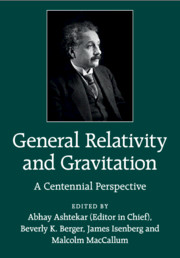Book contents
- Frontmatter
- Contents
- Preface
- List of contributors
- List of figures
- List of tables
- Part One Einstein's Triumph
- 1 100 Years of General Relativity
- 2 Was Einstein Right? A Centenary Assessment
- 3 Relativistic Astrophysics
- 4 Cosmology
- Part Two New Window on the Universe: Gravitational Waves
- Part Three Gravity is Geometry, after all
- Part Four Beyond Einstein
- Index
- References
2 - Was Einstein Right? A Centenary Assessment
from Part One - Einstein's Triumph
Published online by Cambridge University Press: 05 June 2015
- Frontmatter
- Contents
- Preface
- List of contributors
- List of figures
- List of tables
- Part One Einstein's Triumph
- 1 100 Years of General Relativity
- 2 Was Einstein Right? A Centenary Assessment
- 3 Relativistic Astrophysics
- 4 Cosmology
- Part Two New Window on the Universe: Gravitational Waves
- Part Three Gravity is Geometry, after all
- Part Four Beyond Einstein
- Index
- References
Summary
Introduction
When general relativity was born 100 years ago, experimental confirmation was almost a side issue. Admittedly, Einstein did calculate observable effects of general relativity, such as the perihelion advance of Mercury, which he knew to be an unsolved problem, and the deflection of light, which was subsequently verified. But compared to the inner consistency and elegance of the theory, he regarded such empirical questions as almost secondary. He famously stated that if the measurements of light deflection disagreed with the theory he would “feel sorry for the dear Lord, for the theory is correct!”.
By contrast, today at the centenary of Einstein's towering theoretical achievement, experimental gravitation is a major component of the field, characterized by continuing efforts to test the theory's predictions, both in the solar system and in the astronomical world, to detect gravitational waves from astronomical sources, and to search for possible gravitational imprints of phenomena originating in the quantum, high-energy or cosmological realms.
The modern history of experimental relativity can be divided roughly into four periods: Genesis, Hibernation, a Golden Era, and the Quest for Strong Gravity. The Genesis (1887–1919) comprises the period of the two great experiments which were the foundation of relativistic physics – the Michelson–Morley experiment and the Eötvös experiment – and the two immediate confirmations of general relativity – the deflection of light and the perihelion advance of Mercury. Following this was a period of Hibernation (1920–1960) during which theoretical work temporarily outstripped technology and experimental possibilities, and, as a consequence, the field stagnated and was relegated to the backwaters of physics and astronomy.
But beginning around 1960, astronomical discoveries (quasars, pulsars, cosmic background radiation) and new experiments pushed general relativity to the forefront. Experimental gravitation experienced a Golden Era (1960–1980) during which a systematic, world-wide effort took place to understand the observable predictions of general relativity, to compare and contrast them with the predictions of alternative theories of gravity, and to perform new experiments to test them.
- Type
- Chapter
- Information
- General Relativity and GravitationA Centennial Perspective, pp. 49 - 96Publisher: Cambridge University PressPrint publication year: 2015
References
- 7
- Cited by



